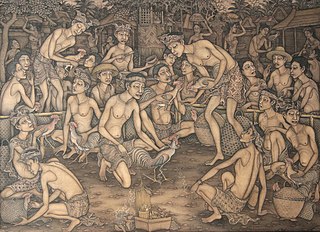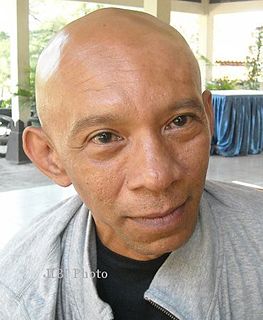
Wayang, also known as wajang, is a traditional form of puppet theatre play originated on the Indonesian island of Java. Wayang refers to the entire dramatic show. Sometimes the leather puppet itself is referred to as wayang. Performances of wayang puppet theatre are accompanied by a gamelan orchestra in Java, and by gender wayang in Bali. The dramatic stories depict mythologies, such as episodes from the Hindu epics the Ramayana and the Mahabharata, as well as local adaptations of cultural legends. Traditionally, a wayang is played out in a ritualized midnight-to-dawn show by a dalang, an artist and spiritual leader; people watch the show from both sides of the screen.

The culture of Indonesia has been shaped by long interaction between original indigenous customs and multiple foreign influences. Indonesia is centrally-located along ancient trading routes between the Far East, South Asia and the Middle East, resulting in many cultural practices being strongly influenced by a multitude of religions, including Buddhism, Christianity, Confucianism, Hinduism, and Islam, all strong in the major trading cities. The result is a complex cultural mixture very different from the original indigenous cultures.
Kompas (Compass) is an Indonesian national newspaper. Published by Kompas Gramedia, it has been in publication since 28 June 1965.

Kompas Gramedia is an Indonesian conglomerate. It has focused on several businesses, predominantly mass media, as well as hospitality, manufacturing, and event organizing.

The National Museum of Indonesia, is an archeological, historical, ethnological, and geographical museum located in Jalan Medan Merdeka Barat, Central Jakarta, right on the west side of Merdeka Square. Popularly known as the Elephant Museum after the elephant statue in its forecourt. Its broad collections cover all of Indonesia's territory and almost all of its history. The museum has endeavoured to preserve Indonesia's heritage for two centuries.

Balinese art is art of Hindu-Javanese origin that grew from the work of artisans of the Majapahit Kingdom, with their expansion to Bali in the late 14th century. From the sixteenth until the twentieth centuries, the village of Kamasan, Klungkung, was the centre of classical Balinese art. During the first part of the twentieth century, new varieties of Balinese art developed. Since the late twentieth century, Ubud and its neighboring villages established a reputation as the center of Balinese art.
Ida Bagus Made Poleng (1915–1999) was a traditional Balinese painter. Known also as Ida Bagus Made Poleng or Ida Bagus Made Tebesaya or simply Gus Made.
Ivan Sagita was born in Malang 1957 and studied at the Indonesian Art Institute in Yogyakarta from 1979-85. He’s known as an introvert and mysterious artist, but his work of art is well known in the world of art.

The Puri Lukisan Ratna Wartha Museum is the oldest art museum in Bali which specialize in modern traditional Balinese paintings and wood carvings. The museum is located in Ubud, Bali, Indonesia. It is home to the finest collection of modern traditional Balinese painting and wood carving on the island, spanning from the pre-Independence war (1930–1945) to the post-Independence war era. The collection includes important examples of all of the artistic styles in Bali including the Sanur, Batuan, Ubud, Young Artist and Keliki schools.

Afrizal Malna, is an Indonesian activist, writer of prose, poetry, and theatrical texts.
Taman Ismail Marzuki, popularly known as TIM,, is an arts, cultural, and science center located at Cikini in Jakarta, Indonesia. Taman Ismail Marzuki complex comprises a number of facilities including six performing arts theaters, cinemas, exhibition hall, gallery, libraries and an archive building. The complex is built on an 9 hectares land area, which was previously a zoo. TIM is named after Ismail Marzuki, one of Indonesia's most influential composers.
Balinese literature refers to the oral and written Balinese language literature of the people of Bali, an island in Indonesia. It is generally divided into two periods: purwa, or traditional; and anyar, or modern.
Kawanku was an Indonesian weekly magazine for teenage girls. It was first published in 1970 as a children's magazine. Kawanku focused on fashion and celebrities and offered information about the latest entertainment and feature stories on current issues and events. The magazine was published by Kompas Gramedia. Its headquarters was in Jakarta.
Heri Dono is an Indonesian visual artist as artist painter, sculptor, and installation artist.

Bentara Budaya Yogyakarta is a cultural center located in Yogyakarta, Indonesia. Bentara Budaya Yogyakarta was opened on 26 September 1982, funded by Kompas Gramedia Group.

Jakob Oetama was an Indonesian senior journalist and businessman who was one of the co-founders and owners of Kompas Gramedia Group, the largest media group in Indonesia. Together with P.K. Ojong in 1965 he established the Kompas daily, the leading national broadsheet newspaper in Indonesia, where he was editor-in-chief until 2000.
Amrus Natalsya - an Indonesian painter and wood sculpture artist.

Indonesian painting has a very long tradition and history in Indonesian art, though because of the climatic conditions very few early examples survive. The earliest Indonesian paintings were the rock paintings of prehistoric times, such as the petroglyphs found in places like in the caves in the district of Maros in Sulawesi, Indonesia. The Stone Age rock paintings found in the Maros cave are approximately 40.000 years old.
Siti Adiyati Subangun, often just known as Siti Adiyati, is a prolific Indonesian Contemporary artist, historically significant as one of the founding members of the Indonesian New Art Movement from 1975 to 1979. She is notable as one of the few women artists involved with the GSRB, alongside Nanik Mirna, with most of the individuals behind the movement being young male artists from Bandung, Jakarta, and Yogyakarta. In her practice as an artist, educator, writer, and activist, Siti Adiyati examines issues of social inequality, environmental degradation, and bureaucratic corruption.











